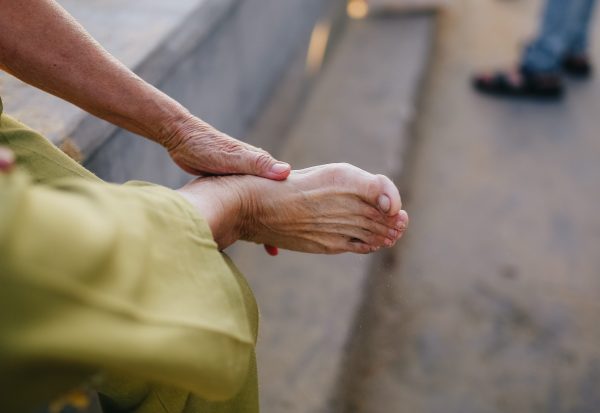Your feet are your body’s foundation. And they’re awesome.
Believe it or not, each foot accounts for about 1.5% or less of your bodyweight. Yet they carry the entire weight of your body around for an entire lifetime. More than that, really. Because when you walk, the pressure on your heels and the front of your feet can be more the double your body weight.
And here’s an amazing little tidbit for you. If you walk 7,500 steps a day, by the end of your life you will have walked the equivalent of about five times around the Earth.
That’s incredible, isn’t it?
So those puppies get a lot of wear and tear over the years. And it’s not uncommon to start experiencing some real problems with your feet as you age.
For example, even though we tend to gain a little body padding as we get older, we seem to lose it in our feet. We lose the cushioning that protects the bones in the feet. So it feels like you’re standing directly on bone. This can make walking and standing painful, especially on uneven surfaces.
I know this for a fact, because I’m starting to experience it. And it’s not pleasant. When I get home from work, I really look forward to a good session using my handy-dandy foot massager. It’s great!
Padded insoles or custom orthotics are great too. They can help add some cushioning under your feet to offset the loss of that all-important fatty tissue. My own orthotics come from the “Happy Feet plus® ” store and what a difference they make.
This is just one thing that can happen to our feet as we grow older.
When Old Feet Get Cranky
The older we get, the crankier our feet become. Three of the most common issues are cracked heels, bunions and Plantar fasciitis.
Cracked heels are quite common. Sometimes it’s just an ugly nuisance. Other times they might be deep and painful. It happens when the skin on your heel gets too dry. When you put pressure on the fatty pad of the heel, it can cause that dry skin to split open.
It’s sort of like if you were wearing a pair of old, dried up running shoes. You put them on, hit the pavement and poof! The sides split out of them as your feet spread out when they hit the ground.
If you have cracked heels, soak your feet in warm (not hot) water for about 20 minutes. Gently pat them dry. Then use a pumice stone, foot scrubber or loofah to file down the hard, thick layers of skin. But don’t over-file, it could lead to an infection. Then apply a good quality natural moisturizer.
If you can’t solve the problem with home treatment, check in with your doctor. It could be a sign of nutritional deficiency, most likely vitamins C and E and B3.
Bunions make it painful to walk, compromise foot function and make it difficult to wear shoes. A podiatrist friend of mine told me over 30 years ago, “As long as women wear high heels, I’ll be doing bunion surgery!”
The way heels slope forward and generally have a narrow toe box often result in painful bunions. These are bony growths that develop at the joint of the big toe… and boy do they hurt!
But men can get bunions too. In fact, did you know that high heels were originally worn by men, not women? It’s true. Their original purpose was to give soldiers stability in their saddle as they battled their enemy. That’s why cowboy style riding boots still have about a two-inch heel – for stability in the saddle.
I recommended avoiding high heels. At best, save them for special occasions. If you already have a bunion, you know these shoes are going to aggravate it. If you decide to wear them anyway, be prepared. Use a bunion pad to lessen the irritation.
And if you have aching heels?
Plantar fasciitis is probably the reason for it. The plantar fascia is a thick band of tissue that supports the arch and connects the heel to the ball of the foot. When it gets inflamed, it can cause a stabbing pain near the heel. Things like running, dancing and standing for long periods can aggravate it.
In many cases, simple stretching and strengthening exercises can help.
For example, try stretching your feet. Just sit down with your legs extended, heels on the floor. Reach down and pull your big toe toward you while lifting your foot away from the floor. Hold for up to 30 seconds. Do this three or four times a day.
If you can’t reach your toes with your hands, wrap a towel around ball of your foot while holding it at both ends. Then straighten your leg and pull the towel toward you while keeping your knee straight.
You can find more exercise ideas online, like this advice from University of Michigan.
What About those Toenails?
Ingrown toenails can be extremely painful. They happen when the edges or your toenails grow into the skin. What causes it? Wearing tight shoes for one. Incorrectly trimming of the nails for another. They should be trimmed straight across, not at an angle.
Ingrown toenails can be treated at home. Soak your feet in warm water for about 20 minutes a couple times a day. Then, pack cotton under the edge.
This should help. If it doesn’t, you might consider having it removed by a professional.
Toenail fungus is pretty ugly. And it doesn’t have a quick fix.
Over-the-counter anti-fungal creams work well if the infection is on the nail surface. But it only works to prevent new fungus from spreading as the nails grow out. So the final results won’t be seen until the new nail is fully grown, which can take six to twelve months.
If you trim your nails and use a file to thin the nail before apply the cream, it helps improve penetration. So that might help a little bit.
But if the fungus has invaded the nailbed, these treatments may not work. In that case, it’s a good idea to take a trip to your podiatrist or dermatologist. They may recommend removing the nail(s) to get rid of the infection.
Your feet are a miracle. Take good care of them, and they’ll carry you far.



